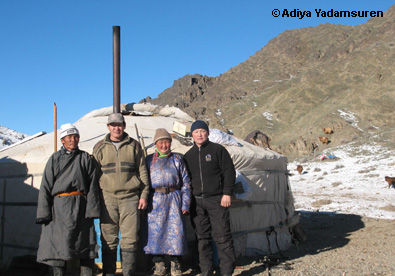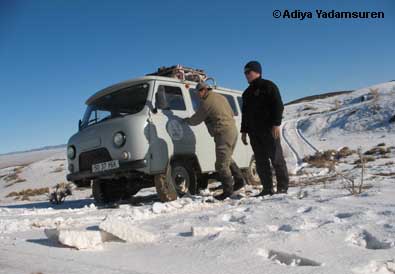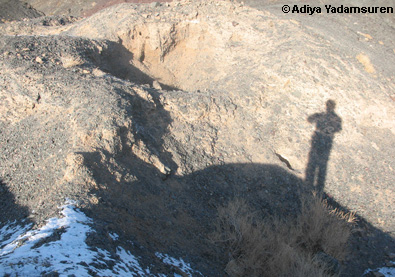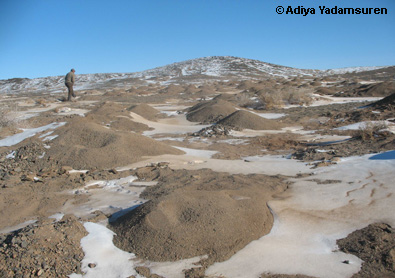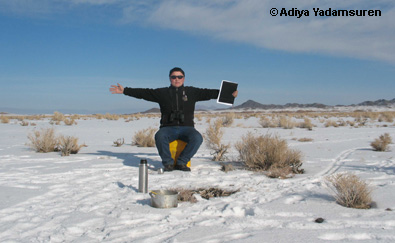Here is Part 2 of our Mongolian EDGE Fellow-Adiya’s survey of the Great Gobi protected area and buffer zone.
(Click here if you haven’t already read Part 1)
During 2007-2008, approximately 15 new families migrated to the National park area for wintering. Those families asked for permission of pasture in the National park area from head of park administration. The new families have got 115 camels, 1352 sheep, 4403 goats, 9 horses (total of 5921 livestock).
The terrible winters and arid conditions of recent years have had a severe impact on the Gobi’s aimag. Many herder families would like to migrate to the National park area and surrounding areas. In this case, the management of National Park contract with heads of administrations for the wintering permission inside protected area of park. This year ten herder families are wintering in middle of Edrene Mountain of the National Park from Erdene. Also three herder families (from Erdene area) and thirteen herder families (from Shivee-Ulaan area) are wintering in the North Mountain and two families are wintering inside the National Park. Therefore, two and three new families are wintering in the North Mountain from Tseel and Togrog areas.
Water sources in winter are a wonderful way to attract family and their herd. Usually families provide source of drinking water from the snow. But for their herd- they provide source of water from a well. The water holes are located 5-20 km from ger. Some families have their own well and it provides source of drinking water for human and livestock. Herders told us about their own well where the water is often not enough in the well for 300 goat and sheep a day. When there is a lot of snow each family can water their herd 2-3 times during the week. Otherwise they can only water them only one time in 2 days.
In the last 30 years, the number of herder family’s has risen around the National Park area. According to ranger D.Tsend in her notice “Herders family number of the Southeast part of Edrene Mountain of the National Park” –at first there were only 8-10 families encamping during 1976-1980s. After then from 1980 to 1987s family number was raised 15-20. Also the number of family’s rose slightly during 87-1995 period up to 20-35. From the year’s 1995-2000 there was a rapid rise in the number of family’s to 35 and then a which increased until 2007 to 67 herder’s family. Beginning in the late 1990, state farm and negdels (agricultural stations) were changed into privately held livestock. This resulted in increasing numbers of new family such as privately farms in above mentioned area.
At the end of last year, snow covered the whole the Gobi landscape making our work really hard. The weather was extremely harsh and we had many problems such as snow storms and windstorms during field research work. Often we had to drive our car off road and sometimes our car was snowed in. In the morning and evening time we consumed so much fuel just for turning on a car and to warm up an engine.
The illegal gold mining
During the research study, we witnessed in some areas very small scale operations in handling extraction of gold within National Park areas. During the study we visited illegal mining sites in buffer zone and core area of the GGSPA.
Some mining site were destroyed by local herder or the people from different areas where they used metal detectors.
We visited in total 10 illegal mining sites. Although we did not see human presence during the our visit, there was mark of camping of illegal miners.
At the end of the road we found 10 abandoned holes, strewn with discarded clothing and lots of burned woods. The gamekeeper said that, usually two and three cars people stay over inside protected area from near places and other places within several days. In some case gamekeeper can catch them and fine them and chase them from the protected area. However, this normally does not happen.
Most of illegal gold miners is kin and friends or family. We were talked about the illegal extraction of gold with herders. Most of herders disagreed with it. This is unsuitable for any kind of extraction of gold because of the risk of pasture. Otherwise, some herders said us that, we should be extracting gold on our own. If we cannot do that, then foreign mines company will extract gold in our land completely. The illegal gold miners would like to enter to the National Park area for searching and extraction of the gold. It becomes common event nowadays. People would like to make a lot of money from the illegal gold extraction in Mongolia today. This process is activating more support than that to save nature and biodiversity. The illegal gold miner and the illegal process is distributing and affecting ever corner of Mongolia’s land.
The End.

